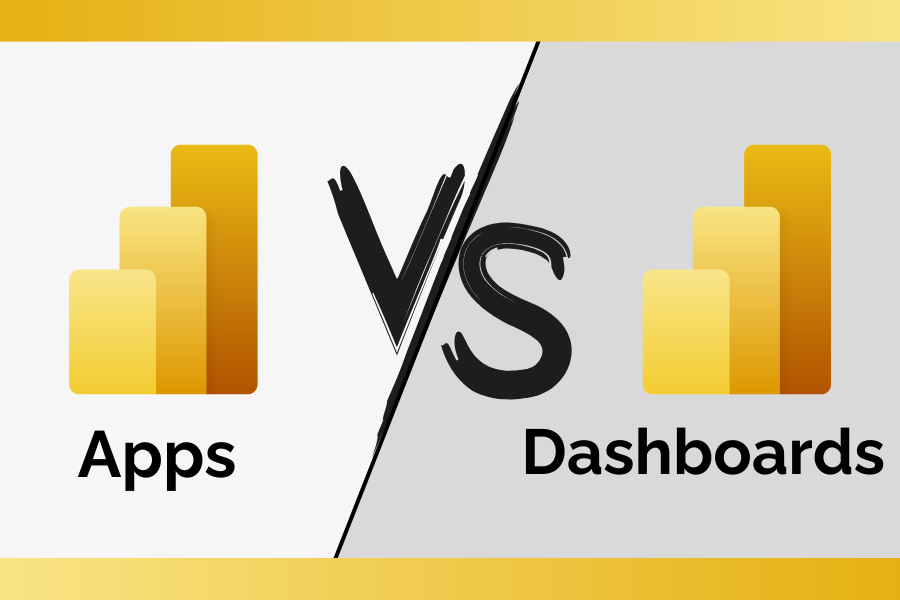What are Power BI Apps?
Power BI Apps are applications that integrate reports and analyses in one place. They combine various elements, such as dashboards, reports, and semantic models, into a cohesive content unit. This allows users to easily access all relevant information in one location, making data analysis and decision-making more efficient.
Features of Power BI Apps:
- Aggregation: Power BI Apps allow combining different types of content, such as dashboards, reports, and semantic models, into a single application.
- Availability on multiple devices: Apps are optimized for different devices, ensuring easy access to analyses anywhere, anytime.
- User customization: Power BI Apps enable content design tailored to user requirements, allowing for personalized experiences and better alignment with individual needs.
Benefits for organizations:
- Easy Access to key reports: Power BI Apps centralize crucial information, making it easier to quickly locate necessary reports and analyses.
- Personalized user experiences: The ability to customize the app to individual needs enhances data comprehension and supports better decision-making.
When to use Power BI Apps?
Power BI Apps are designed for effectively distributing a set of reports and dashboards to a broad audience within an organization. Although the name is similar to Power Apps, these tools serve different purposes. Power Apps is a separate tool for creating low-code or no-code applications for various business needs. Power BI Apps, on the other hand, is a solution used when central management and sharing of data analysis content, such as reports and dashboards, is necessary for a large user base.
Power BI Apps are particularly useful when not all users need the ability to create or edit content. Some users may only need to interact with reports and dashboards. With Power BI Apps, you can separate production-ready content and deliver it to users in a read-only version, while development and testing processes remain in the Workspace structure. This approach helps maintain data integrity while simplifying user management.
For organizations using Power BI Premium, the Deployment Pipelines feature adds an additional layer of control, allowing the creation of separate Workspaces for development, testing, and production. This facilitates a more organized lifecycle management process.
Power BI Apps are ideal for organizations that need to distribute standardized, secure, and organized reports and dashboards to specific user groups. With easy updates, users always have access to the latest data and content. Power BI Apps also support secure data sharing with precise access control, allowing administrators to customize permissions based on user roles. Additionally, these apps offer a personalized user experience aligned with the organization’s branding, ensuring consistency across the platform.
What are Dashboards in Power BI?
Dashboards in Power BI are interactive visualizations that allow real-time data monitoring. They consist of various elements, such as charts, tables, or maps, presenting key metrics and information in an accessible and understandable way.
Features of dashboards:
- Viewing data in the form of charts, tables, and maps – dashboards allow data to be presented in various visual formats, which makes analysis and interpretation easier.
- Filtering and drill-down – users can filter data and drill down into details, enabling more precise analysis and uncovering hidden relationships.
Benefits for organizations:
- Quick access to critical metrics – dashboards provide immediate insight into key data, allowing for faster decision-making and responses to changes.
- Data analysis at various levels of detail – the ability to adjust the data view allows for both high-level trend analysis and detailed information, supporting decision-making at different organizational levels.
Key differences between Power BI Apps and Dashboards
The choice between Power BI Apps and dashboards depends on an organization’s specific needs for data analysis and reporting.
- Purpose – Power BI Apps are comprehensive solutions for integrating multiple reports and analyses in one place, simplifying content management and sharing with a broad user base.
Dashboards in Power BI are interactive visualizations focused on real-time data monitoring, providing quick access to key metrics.
- Personalization – Power BI Apps offer a highly personalized user experience, enabling customization of the app according to the specific needs and preferences of the audience.
Dashboards are more standardized, aimed at monitoring overall metrics, making them less flexible in terms of personalization.
- Customization – Power BI Apps allow flexible customization to the specific needs of an organization, enabling the creation of personalized sets of reports and analyses.
Dashboards are generally more standardized in structure, focusing on presenting key metrics in a consistent and easy-to-understand manner.
Summary
Power BI Apps and dashboards offer different approaches to data analysis and reporting. Apps focus on aggregating and personalizing content for a wide audience, while dashboards are centered on real-time data monitoring with interactive visualizations.
Companies can benefit from both tools by using Power BI Apps for distributing integrated reports to a broad audience and dashboards for monitoring key metrics in real time. This approach allows for comprehensive data management and supports decision-making across different levels of the organization.
To maximize the potential of Power BI, it’s worth consulting with experts who can help select and implement solutions that best suit your organization’s specific needs. Contact us today for a free consultation!

